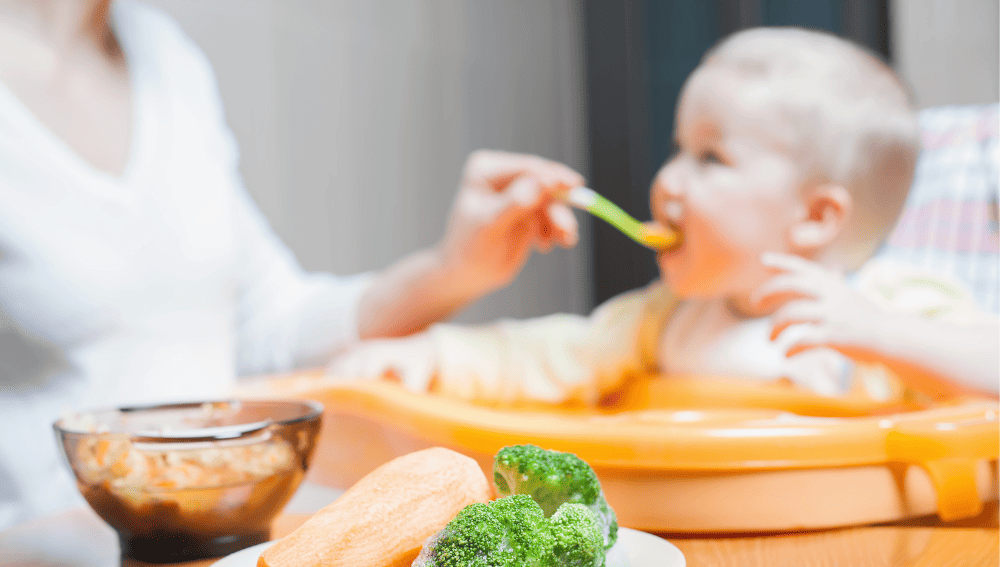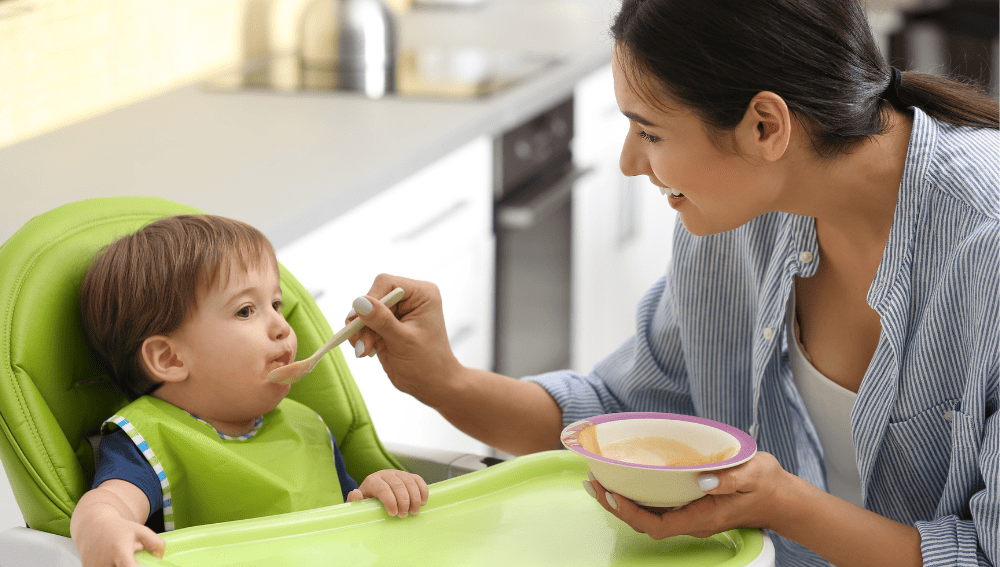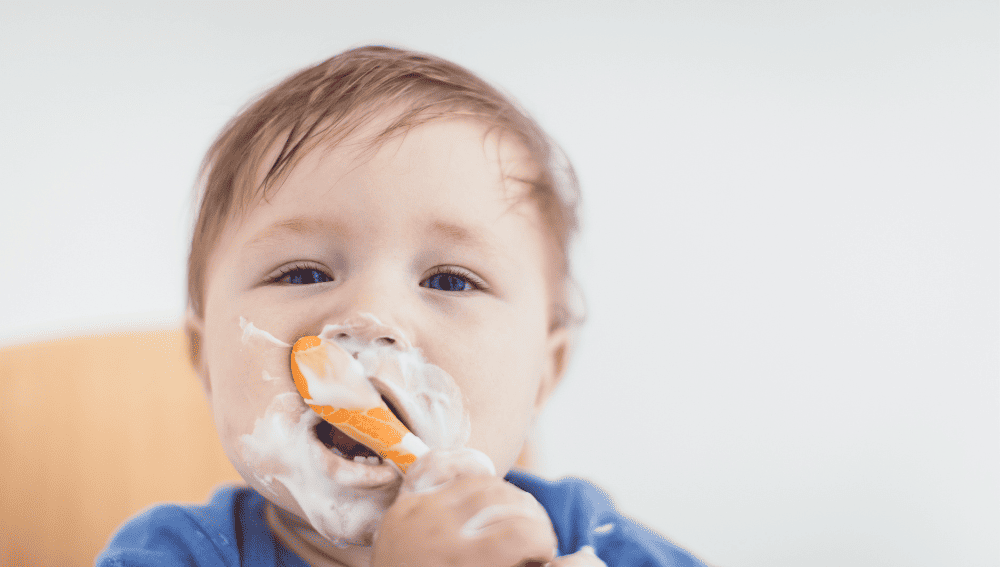When babies start eating solid foods, their bowel movements change. New parents may be surprised by the color, texture, and frequency of their baby’s poop.
Understanding what to expect can help parents feel more confident and prepared as they introduce their baby to solid foods.
The transition from milk to solid foods is a gradual process. Babies may initially have a hard time digesting new foods, which can cause changes in their bowel movements.
As their digestive system adapts, their poop will start to look more like adult poop. It’s important for parents to keep an eye on their baby’s poop and make note of any changes, as this can be an indicator of their baby’s overall health.
Key Takeaways
- Introducing solid foods can cause changes in a baby’s bowel movements.
- Parents should pay attention to the color, texture, and frequency of their baby’s poop.
- Changes in a baby’s poop can be an indicator of their overall health.
Understanding Baby Poop When Starting Solids
When babies start eating solid foods, their poop will change in color, texture, and frequency. It is important for parents to understand these changes to ensure their baby is healthy and getting the right nutrition.
Poop Changes
The first thing parents will notice is a change in poop color. Breastfed baby poop is typically yellow or green, but when starting solids, it can become brown or even orange. This is normal and nothing to worry about.
The texture of baby poop will also change. Breastfed baby poop is usually soft and mushy, but when starting solids, it can become thicker and more formed. This is also normal, as solid foods are more difficult to digest than breast milk.
Finally, parents may notice a change in poop frequency. Breastfed babies can poop multiple times a day, but when starting solids, they may only poop once a day or every other day. This is also normal, as solid foods take longer to digest.
Baby Poop and Solid Foods
When starting solids, it is important to introduce new foods slowly and one at a time. This will help parents identify any food allergies or intolerances. It is also important to ensure that babies are getting enough iron and other nutrients from their solid foods.
Parents should also pay attention to their baby’s poop to ensure they are digesting their food properly. If the poop is hard and dry, it may indicate that the baby is constipated and needs more water or fiber in their diet.
If the poop is very loose or watery, it may indicate diarrhea and the baby may need to see a doctor.
In conclusion, understanding baby poop when starting solids is an important part of ensuring a baby’s health and nutrition.
Parents should pay attention to poop color, texture, and frequency, and introduce new foods slowly and one at a time. If parents have any concerns about their baby’s poop, they should speak to their pediatrician.
The Role of Age in Introducing Solids
When it comes to starting solids, age plays a crucial role in determining when to begin and what foods to offer. The American Academy of Pediatrics recommends introducing solid foods between 4 and 6 months of age, but every baby is different and may be ready at different times.
It’s important to wait until your baby is developmentally ready to handle solid foods. Signs of readiness include being able to sit up with support, showing interest in food, and being able to move food from the front to the back of their mouth.
Starting solids too early can increase the risk of choking and may not provide any nutritional benefits. Waiting too long to start solids can also be problematic, as babies need a variety of nutrients to support their growth and development.
When introducing solids, it’s important to start with single-ingredient purees and gradually introduce new foods one at a time to watch for any allergic reactions. It’s also important to offer a variety of foods to ensure your baby is getting all the nutrients they need.
Overall, age is an important factor to consider when starting solids, but it’s not the only one. It’s important to watch for signs of readiness and offer a variety of nutritious foods to support your baby’s growth and development.
Changes in Bowel Movements
When babies start eating solid foods, their bowel movements may change in frequency, consistency, and color. It is important for parents to understand what is normal and what is not, so they can recognize any potential problems.
Frequency
It is normal for a baby’s bowel movements to change in frequency when they start solids. Breastfed babies may have bowel movements every day or even several times a day, while formula-fed babies may have fewer bowel movements.
When starting solids, babies may have fewer bowel movements than before, but this is not necessarily a cause for concern as long as the stools are soft and easy to pass.
Consistency
The consistency of a baby’s stool may also change when they start solids. Breastfed babies typically have soft, runny stools, while formula-fed babies have firmer stools.
When starting solids, a baby’s stools may become thicker and more formed. However, if the stools become hard and dry, this may indicate constipation.
Color
The color of a baby’s stool may also change when they start solids. Breastfed baby poop is typically yellow or green, while formula-fed baby poop is usually tan or yellow. When starting solids, the color of a baby’s poop may change depending on the foods they are eating.
For example, if a baby eats beets, their poop may be reddish in color. However, if a baby’s poop is consistently white or gray, this may indicate a problem with their liver or gallbladder.
Pattern
Parents should also pay attention to their baby’s bowel movement pattern. While it is normal for a baby’s bowel movements to change in frequency and consistency, a sudden change in pattern may indicate a problem.
For example, if a baby who usually has bowel movements every day suddenly goes several days without a bowel movement, this may indicate constipation. Similarly, if a baby who usually has soft, easy-to-pass stools suddenly has hard, dry stools, this may also indicate constipation.
In summary, parents should expect changes in their baby’s bowel movements when starting solids. However, they should also be aware of what is normal and what is not, so they can recognize any potential problems.
By paying attention to frequency, consistency, color, and pattern, parents can ensure their baby’s digestive system is healthy and functioning properly.
Color and Texture of Baby Poop
When babies start solids, their poop undergoes significant changes in color and texture. Parents should pay attention to the color and texture of their baby’s poop to ensure that their little one is healthy and getting the right nutrition.
Color
The color of baby poop can vary depending on the type of food they eat. Here are some common colors parents may see:
- Green: If a baby’s poop is green, it could mean that they are eating a lot of green vegetables or that their digestive system is moving too quickly.
- Red: If a baby’s poop is red, it could be a sign of blood in the stool, which requires immediate medical attention.
- Yellow: A yellow color is normal for baby poop and indicates that the baby is getting enough breast milk or formula.
- Brown: Brown is also a normal color for baby poop and indicates that the baby is digesting food properly.
- Black: Black poop can be a sign of iron supplements or a reaction to medication, so parents should consult their pediatrician.
- Grey: Grey poop can indicate a problem with the baby’s liver or gallbladder, so parents should consult their pediatrician.
- Orange: Orange poop can indicate that the baby is eating a lot of orange foods, such as carrots or sweet potatoes.
- Tan: Tan poop can indicate that the baby is eating a lot of starchy foods, such as rice or potatoes.
Texture
The texture of baby poop can also vary depending on the type of food they eat. Here are some common textures parents may see:
- Runny: Runny poop is normal for breastfed babies and indicates that they are getting enough milk.
- Soft: Soft poop is normal for babies who are eating solid foods and indicates that they are digesting food properly.
- Hard: Hard poop can be a sign of constipation, so parents should consult their pediatrician.
- Seedy: Seedy poop is normal for breastfed babies and indicates that they are getting enough milk.
- Mucousy: Mucousy poop can be a sign of an infection or allergy, so parents should consult their pediatrician.
In conclusion, parents should pay attention to the color and texture of their baby’s poop to ensure that they are healthy and getting the right nutrition. If parents notice any unusual colors or textures, they should consult their pediatrician.
Influence of Diet on Baby Poop
When babies start eating solid foods, their poop can change in color, texture, and frequency. The baby’s diet plays a significant role in determining these changes. Here are some of the ways different foods can affect baby poop:
- Rice cereal: Rice cereal is a popular first food for babies. It is easy to digest and unlikely to cause an allergic reaction. However, it can cause constipation in some babies, leading to harder and firmer stools.
- Carrots: Carrots are a good source of vitamins and minerals, but they can also turn baby poop orange. This is because carrots contain beta-carotene, which is converted into vitamin A by the body and can change the color of poop.
- Vegetables and fruits: Vegetables and fruits are excellent sources of fiber, which can help regulate bowel movements and prevent constipation. However, some fruits and vegetables, such as spinach and peas, can cause green poop, which is usually nothing to worry about.
- Bananas: Bananas are a great source of potassium and other nutrients, but they can also cause constipation in some babies. This can lead to harder and firmer stools.
- Cheese and egg: These foods are high in protein and fat, which can lead to firmer and more odorous poop. However, they are also important sources of nutrition for babies and should be included in their diet in moderation.
- Seeds and nuts: These foods can be introduced to babies after they have been eating solid foods for a few months. However, they should be ground or mashed into a smooth paste to prevent choking. Some nuts, such as peanuts, can also cause an allergic reaction in some babies.
- Wheat: Wheat is a common allergen and should be introduced to babies with caution. It can also cause constipation in some babies.
In conclusion, a baby’s diet can have a significant impact on their poop. Parents should introduce new foods slowly and monitor their baby’s poop for any changes in color, texture, or frequency. If they notice anything unusual, they should consult their pediatrician.
Transitioning from Breastfeeding to Solids
When a baby starts transitioning from breastfeeding to solids, it can be an exciting and nerve-wracking time for both the baby and the parents.
Breast milk provides all the necessary nutrients for a baby’s growth and development, so it’s important to introduce solids at the right time and in the right way.
The American Academy of Pediatrics recommends starting solids between 4 and 6 months of age, when the baby is showing signs of readiness.
These signs include sitting up with support, showing interest in food, and being able to hold their head up. It’s important to note that every baby is different, and some may not be ready until closer to 6 months.
When introducing solids, it’s important to continue breastfeeding or offering breast milk as the primary source of nutrition.
Solids should be introduced slowly, one at a time, to allow the baby to adjust to the new tastes and textures. It’s also important to offer a variety of foods to ensure the baby is getting all the necessary nutrients.
Breastfed babies may take some time to adjust to the new textures and flavors of solids, as breast milk has a different taste and consistency.
Parents should be patient and not force the baby to eat if they are not interested. It’s also important to continue nursing on demand, as breast milk provides important antibodies and immune support.
In conclusion, transitioning from breastfeeding to solids can be a gradual and exciting process. By following the baby’s cues and introducing solids slowly, parents can ensure their baby is getting all the necessary nutrients while still receiving the benefits of breast milk.
Impact of Formula Feeding on Baby Poop
Formula feeding can have a significant impact on the consistency and color of baby poop. Infant formula is designed to provide the necessary nutrients for a baby’s growth and development, but it can also affect the digestive system and the way baby poop looks and smells.
One of the most notable differences between formula-fed and breastfed baby poop is the consistency. Formula-fed baby poop tends to be firmer and more formed than breastfed baby poop, which is often runny and seedy.
This is because formula is more difficult to digest than breast milk, and it takes longer for the body to break it down.
The color of formula-fed baby poop can also be different from breastfed baby poop. Formula-fed baby poop is usually tan or yellow, while breastfed baby poop is often a mustardy yellow color.
However, it is important to note that there is a wide range of normal when it comes to baby poop color, and variations are usually nothing to worry about.
Formula-fed babies may also have less frequent bowel movements than breastfed babies. While breastfed babies may have several bowel movements a day, formula-fed babies may only have one or two.
This is because formula is less easily digested than breast milk, so it takes longer to move through the digestive system.
Overall, formula feeding can have a significant impact on the consistency and frequency of baby poop. While these differences may be noticeable, they are usually nothing to worry about and are a normal part of the digestive process for formula-fed babies.
Signs of Constipation and Remedies
When babies start eating solid foods, it is common for them to experience constipation. Constipation is defined as having difficulty passing stools or having fewer bowel movements than usual.
The following are signs that a baby may be constipated:
- Hard, dry stools that are difficult to pass
- Straining or crying during bowel movements
- Fewer bowel movements than usual
- Blood in the stool due to small tears in the anus caused by straining
If a baby is experiencing constipation, there are several remedies that can help relieve the discomfort. Here are a few remedies to try:
- Offer water or juice: Water or juice can help soften stools and make them easier to pass. However, it is important to note that juice should be given in moderation and only after a baby is six months old.
- Increase fiber intake: Adding fiber-rich foods to a baby’s diet can help promote regular bowel movements. Examples of high-fiber foods include prunes, pears, peas, and oatmeal.
- Massage the baby’s belly: Gently massaging a baby’s belly can help stimulate bowel movements and relieve constipation.
- Use medication: If natural remedies do not work, a healthcare provider may recommend medication to help relieve constipation. However, it is important to always consult with a healthcare provider before giving a baby any medication.
It is important to note that dehydration can also contribute to constipation. Therefore, it is essential to ensure that a baby is getting enough fluids throughout the day.
If a baby continues to experience constipation despite trying these remedies, it is important to consult with a healthcare provider to rule out any underlying medical conditions.
Food Allergies and Baby Poop
When starting solids, it is important to be aware of the potential for food allergies in babies. Allergic reactions can manifest in a variety of ways, including through changes in baby poop.
Here are some things to keep in mind:
- Food allergies can cause a range of symptoms, including rashes, hives, vomiting, diarrhea, and changes in baby poop.
- If you suspect your baby may have a food allergy, it is important to speak with a healthcare provider. They may recommend an elimination diet or allergy testing to determine the cause of the reaction.
- Some common allergenic foods to watch out for when starting solids include milk, eggs, peanuts, tree nuts, soy, wheat, fish, and shellfish.
- It is important to introduce new foods one at a time, waiting a few days before introducing another new food. This can help you identify which foods may be causing a reaction.
- If you notice changes in baby poop, such as diarrhea or blood in the stool, it is important to speak with a healthcare provider. They can help determine whether the changes are due to a food allergy or another underlying issue.
Overall, while food allergies can be a concern when starting solids, it is important to remember that most babies do not have food allergies.
By introducing new foods slowly and monitoring for any signs of reaction, parents can help ensure their baby stays healthy and happy as they explore new flavors and textures.
When to Consult a Pediatrician
While starting solids is an exciting milestone for both parents and babies, it can also be a time of concern and confusion. It is important to know when to reach out to a pediatrician for guidance and support.
Here are some situations where seeking medical advice is recommended:
- Persistent diarrhea or constipation: If a baby experiences diarrhea or constipation for more than a few days, it is important to consult a pediatrician. These issues can be a sign of an underlying health problem or an intolerance to a certain food.
- Vomiting: If a baby vomits frequently or forcefully, or if there is blood in the vomit, it is important to seek medical attention. Vomiting can lead to dehydration, which can be dangerous for babies.
- Allergic reactions: If a baby experiences symptoms of an allergic reaction, such as hives, swelling, or difficulty breathing, it is important to seek emergency medical attention. Allergic reactions can be life-threatening.
- Feeding difficulties: If a baby has trouble swallowing, is choking frequently, or is refusing to eat, it is important to consult a pediatrician. These issues can be a sign of a feeding disorder or an underlying health problem.
- Weight loss or failure to thrive: If a baby is losing weight or not gaining weight as expected, it is important to consult a pediatrician. This can be a sign of an underlying health problem or a feeding issue.
It is important to trust your instincts as a parent and seek medical attention if you have any concerns about your baby’s health. A pediatrician can provide guidance and support to ensure that your baby is healthy and thriving.
Related post: Do Babies Poop in Their Sleep
Frequently Asked Questions
How often should a baby poop when starting solids?
It is normal for a baby’s bowel movements to change when starting solids. Some babies may poop more frequently, while others may poop less often. As long as your baby is pooping at least once a day, there is no need to worry.
What should a baby’s poop be like after starting solids?
After starting solids, a baby’s poop will change in color, texture, and smell. It may become thicker, more formed, and darker in color. It may also have a stronger odor. This is all normal and nothing to worry about.
Should I stop giving solids if my baby is constipated?
If your baby is constipated, you may want to offer them more water or breast milk to help soften their stools. You can also try giving them foods that are high in fiber, such as prunes, pears, and peas.
However, you should not stop giving solids altogether, as they are an important part of your baby’s diet.
What should I do if my breastfed baby is not pooping after starting solids?
Breastfed babies may go several days without pooping, even after starting solids. This is normal, as breast milk is easily digested and may not produce as much waste. If your baby is not showing any signs of discomfort, there is no need to worry.
Why is my baby’s poop green after starting solids?
Green poop is normal and can be caused by a variety of factors, including the introduction of new foods, an imbalance of bacteria in the gut, or a viral infection. As long as your baby is otherwise healthy and not showing any signs of discomfort, there is no need to worry.
Is it normal for my baby to have an upset stomach after starting solids?
It is not uncommon for babies to experience some digestive discomfort when starting solids. This can include gas, bloating, and diarrhea. However, if your baby is experiencing severe symptoms or is not able to keep any food down, you should consult your pediatrician.
Also see: Is Too Much Milk Bad For Toddlers

Nurse Practitioner at Venus Med Spa




